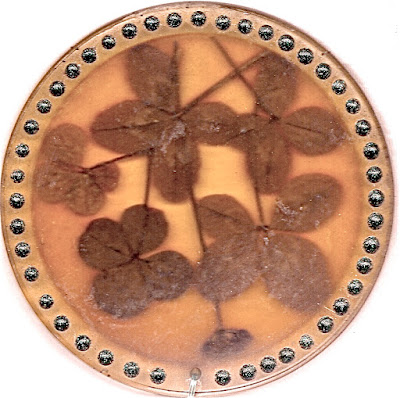As St. Patrick's Day is tomorrow I thought I'd show you a few of my "lucky" finds through the years. Many have been kept in between pages of books, some are laminated on paper or plastic, some are in plastic paperweights, some are incorporated in crafts that permanently cover and seal them, and some are out there waiting for me to find them. Many have dried and broken and turned to dust through the years but I'll try to show a few here.
Are you one of those people who, when walking on a grassy area just look down and one grabs your eye? This has happened ever since I was a young child when my dad planted clover throughout his lawns. I have also plucked several five'ers through the years and I do remember a six'er!
Many of these photos were taken a long time ago and then scanned. The last one is today's and shows my hand holding a resin paperweight that I use often.






Fast Facts About Four-Leaf Clovers
- There are approximately 10,000 three-leaf clovers for every "lucky" four-leaf clover.
- There are no clover plants that naturally produce four leaves, which is why four-leaf clovers are so rare.
- The leaves of four-leaf clovers are said to stand for faith, hope, love, and luck.
- It's often said that Ireland is home to more four-leaf clovers than any other place, giving meaning to the phrase "the luck of the Irish."
- If you're lucky enough to find a four-leaf clover, look for more! If a clover plant produces a four-leaf clover, it's more likely to produce another four-leaf lucky charm than plants that only produce three-leaf clovers.
- The fourth leaf can be smaller or a different shade of green than the other three leaves
- If you're the superstitious type, give your four-leaf clover to someone else. It's said that this will double your good luck!
Today, looking for four-leaf clovers is a St. Patrick's Day tradition, but have you ever wondered why they're considered lucky—or how they came to be associated with the holiday? It turns out, the story behind the clovers dates back to hundreds of years before we began drinking green beer and pinching friends who didn't wear green on the holiday.
Four-leaf clovers commonly appear in centuries-old legends as symbols of good luck. The Druids (Celtic priests), in the early days of Ireland, believed that when they carried a three-leaf clover or shamrock, they could see evil spirits coming and have a chance to escape in time. Four-leaf clovers were Celtic charms, presumed to offer magical protection and ward off bad luck. Children in the Middle Ages believed if they carried a four-leaf clover, they would be able to see fairies, and the first literary reference to suggest their good fortune was made in 1620 by Sir John Melton.
Information taken from "Better Homes & Gardens"

I love it!! Now I feel lucky today!
ReplyDeleteHow extraordinary!! Guess I will have to go to Ireland now. 🍀
ReplyDeleteSince I am also a collector of 4-leaf clovers, I enjoyed this post so much. My little notebooks have them gracing many a page.
ReplyDeleteLove the Olde Lore!!!!! Thank you.
ReplyDeleteAgain, I never saw this post.
Must try to fix my Blog List which is supposed to show me new posts, when they are posted.